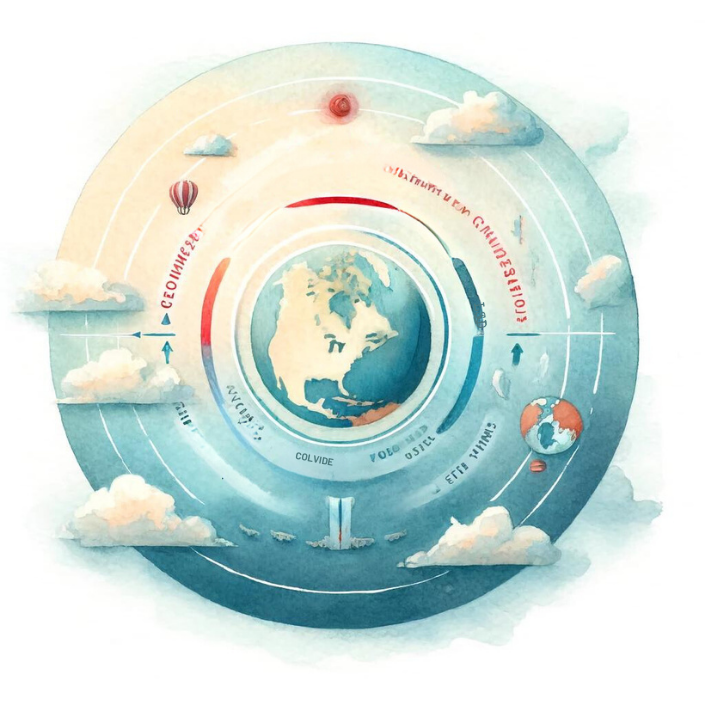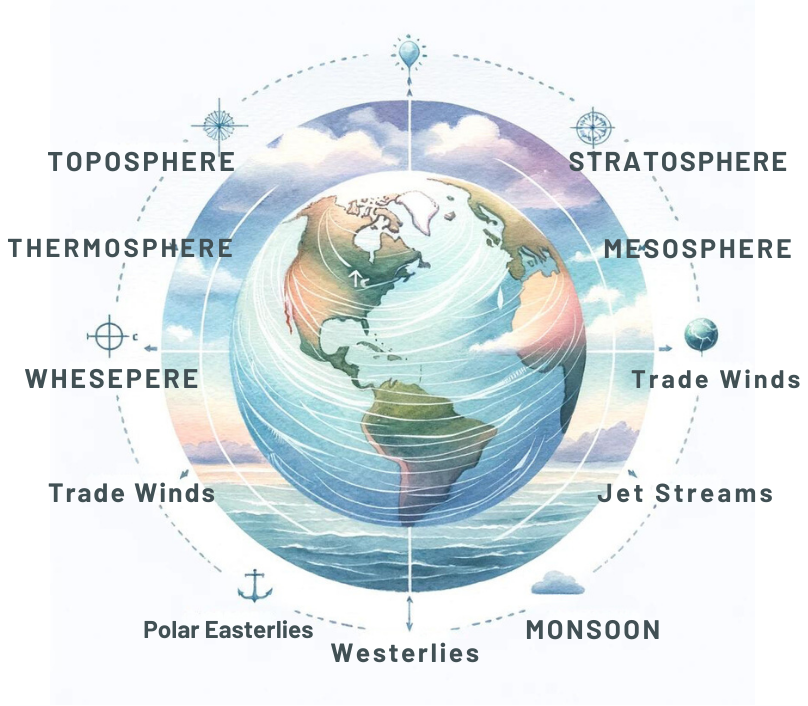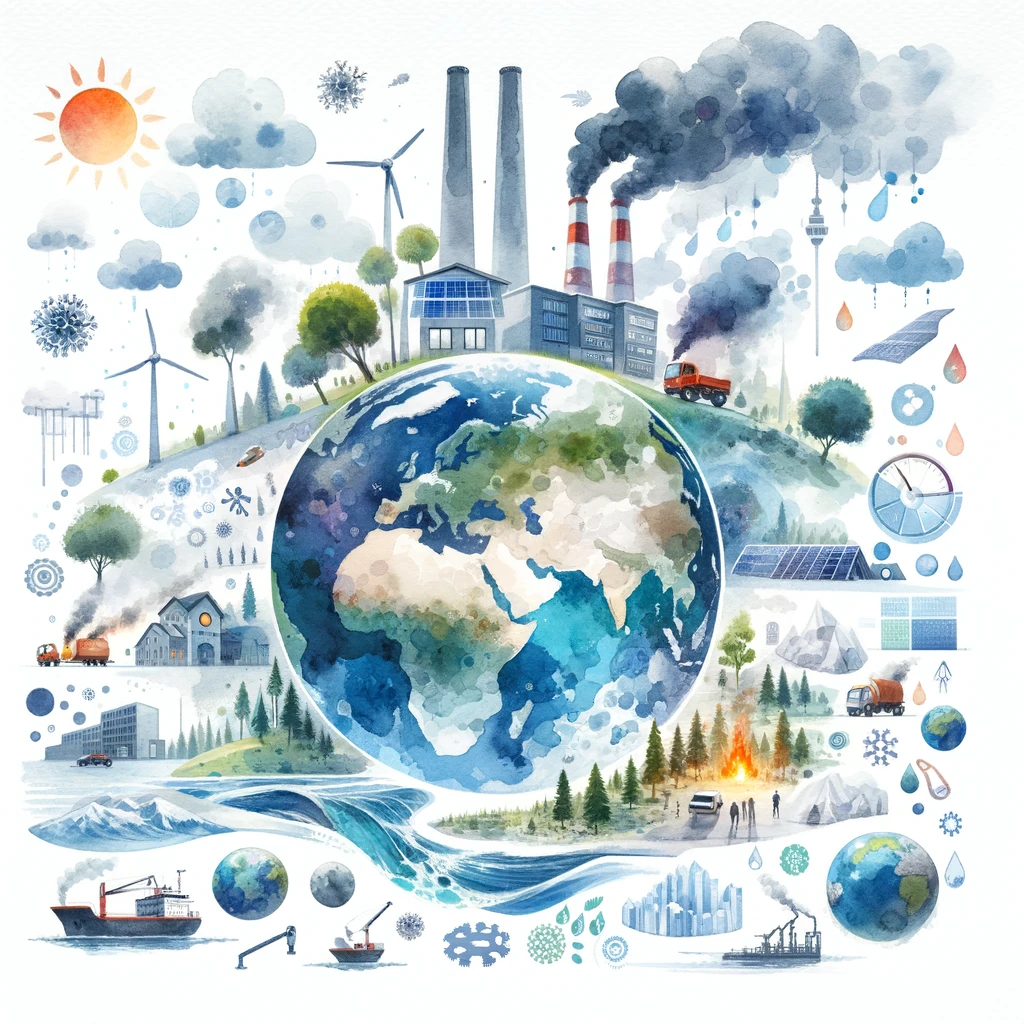General Circulation of the Atmosphere
The general circulation of the atmosphere refers to the large-scale movement of air that helps distribute thermal energy (heat) across the surface of the Earth. This circulation is crucial in determining the climate and weather patterns globally. Understanding this concept involves studying various atmospheric layers, wind patterns, jet streams, and monsoon systems.

Atmospheric Layers
The Earth’s atmosphere is divided into several layers, each with distinct characteristics and significance:
1. Troposphere:
- Characteristics: The lowest layer, extending up to about 8-15 kilometers (5-9 miles) above sea level. It contains about 75% of the atmosphere’s mass and almost all of its water vapor.
- Significance: This is where weather occurs, including clouds, rain, and storms. The temperature decreases with altitude in this layer.
2. Stratosphere:
- Characteristics: Extends from the top of the troposphere to about 50 kilometers (31 miles) above the Earth. It contains the ozone layer, which absorbs and scatters ultraviolet solar radiation.
- Significance: The presence of the ozone layer is crucial for protecting life on Earth from harmful UV radiation. Temperature increases with altitude due to the absorption of radiation by ozone.
3. Mesosphere:
- Characteristics: Extends from 50 kilometers to about 85 kilometers (53 miles) above the Earth. It is the coldest layer of the atmosphere.
- Significance: Meteors burn up in this layer upon entering the Earth’s atmosphere. Temperature decreases with altitude.
4. Thermosphere:
- Characteristics: Extends from about 85 kilometers to 600 kilometers (373 miles) above the Earth. It is characterized by high temperatures, which can rise above 2,500 degrees Celsius (4,532 degrees Fahrenheit).
- Significance: Contains the ionosphere, which is essential for radio communication. The auroras (Northern and Southern Lights) occur in this layer.

Global Wind Patterns
The general circulation of the atmosphere creates distinct wind patterns that significantly influence climate:
1. Trade Winds:
- Mechanism: Blow from the subtropical high-pressure belts towards the equatorial low-pressure zone. They blow from the northeast in the Northern Hemisphere and from the southeast in the Southern Hemisphere.
- Impact on Climate: These winds are responsible for the weather patterns in the tropics and play a crucial role in ocean currents, such as the Atlantic’s Gulf Stream.
2. Westerlies:
- Mechanism: Blow from the subtropical high-pressure areas towards the subpolar low-pressure areas. They move from the west to the east in both hemispheres.
- Impact on Climate: These winds affect the weather patterns in the mid-latitudes, influencing the climate of regions like Europe, North America, and southern Australia.
3. Polar Easterlies:
- Mechanism: Blow from the polar high-pressure areas towards the subpolar low-pressure areas. They move from east to west.
- Impact on Climate: These winds are cold and dry, influencing the polar and subpolar regions’ weather patterns, contributing to the cold climate of these areas.
Jet Streams
Jet streams are fast-flowing, narrow air currents found in the upper levels of the atmosphere, typically in the tropopause:
1. Characteristics:
- High-altitude, high-speed winds, usually flowing west to east.
- Located near the boundaries of major air masses, such as the polar and subtropical regions.
2. Types:
- Polar Jet Streams: Found at altitudes of 7-12 kilometers above sea level, near the polar front, where cold polar air meets warmer air.
- Subtropical Jet Streams: Located at higher altitudes, around 10-16 kilometers, closer to the tropics.
3. Influence on Weather Patterns and Aviation:
- Weather Patterns: Jet streams influence the development and movement of weather systems. They can steer storm systems and affect their intensity.
- Aviation: Pilots use jet streams to reduce travel time and fuel consumption. However, jet streams can also cause turbulence.
Monsoon Systems
Monsoons are seasonal wind patterns that cause wet and dry seasons in many parts of the tropics and subtropics:
1. Mechanisms of Monsoons:
- Indian Monsoon: Driven by the differential heating of the land and sea. In summer, the land heats up faster than the ocean, creating low pressure over the Indian subcontinent and drawing moist air from the ocean, causing heavy rains. In winter, the process reverses, leading to dry conditions.
- East Asian Monsoon: Similar mechanism as the Indian monsoon, with winter monsoon bringing cold, dry air from the interior of Asia, and the summer monsoon bringing warm, moist air from the Pacific Ocean.
2. Impacts on Agriculture and Economy:
- Agriculture: Monsoons are crucial for agriculture in regions like India and Southeast Asia, where a significant portion of the annual rainfall is received during the monsoon season. Good monsoon rains are essential for the cultivation of crops such as rice, which is a staple food in these regions.
- Economy: The monsoon significantly impacts the economy, particularly in countries where agriculture forms a large part of the GDP. Adequate rainfall ensures good crop yields, which influences food prices, rural incomes, and overall economic stability.
3. Climate Change Effects:
- Variability: Climate change is causing increased variability in monsoon patterns, leading to more frequent droughts and floods.
- Intensity: There is evidence suggesting that monsoon intensity may increase, leading to more extreme weather events.
- Adaptation: Countries affected by monsoons need to develop adaptive strategies to mitigate the impacts of these changes on agriculture and water resources.
Conclusion
Understanding the general circulation of the atmosphere, including atmospheric layers, global wind patterns, jet streams, and monsoon systems, is crucial for grasping the Earth’s climate and weather dynamics. These concepts are essential for UPSC aspirants, providing a foundational knowledge that is vital for answering questions related to geography, environment, and climate change in the examination.



